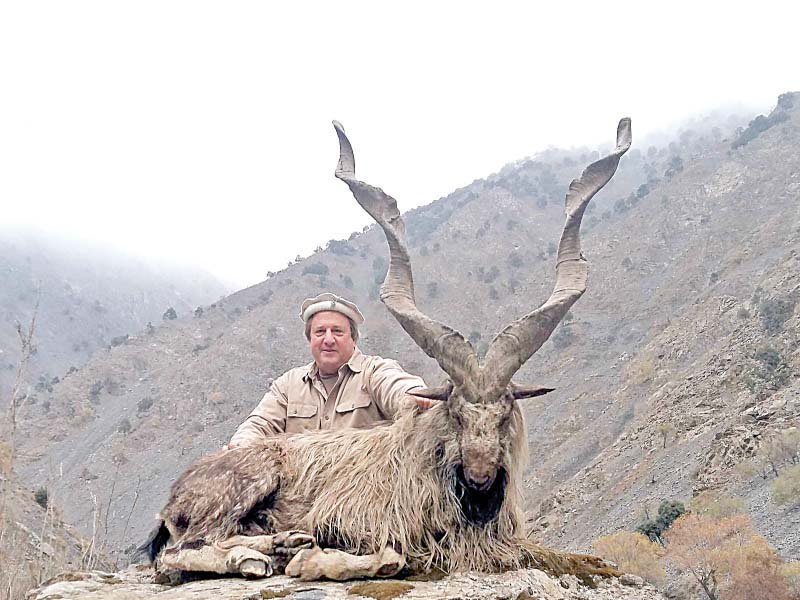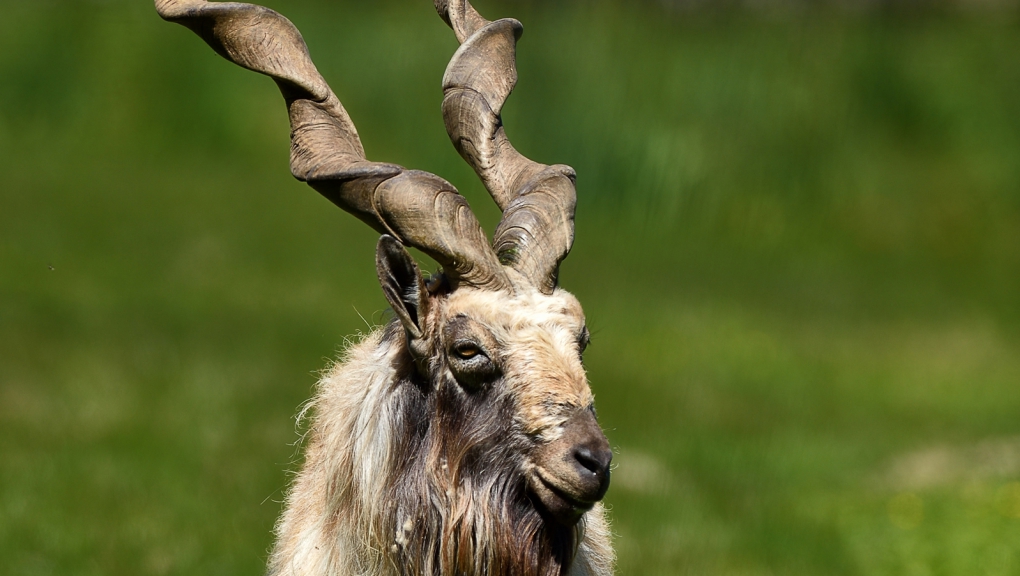Pakistan is home to diverse wildlife, and its national animal, the Markhor (Capra falconeri), is a majestic wild goat that symbolizes strength and resilience. This article explores its significance, characteristics, habitat, and conservation efforts. The Markhor is not only a significant part of Pakistan’s rich biodiversity but also holds great historical and cultural importance in the region.

The Markhor: An Overview
The markhor (Capra falconeri) is a magnificent wild goat native to the rugged mountainous regions of Central and South Asia, particularly in Pakistan, Afghanistan, India, Tajikistan, and Uzbekistan. Recognized for its majestic spiraled horns and thick, coarse coat, the markhor is well-adapted to steep, rocky terrains, using its strong legs and sharp hooves to navigate cliffs and evade predators like snow leopards and wolves. These diurnal herbivores primarily graze on grasses, leaves, and shrubs, forming small herds led by females, while males remain largely solitary, joining only during the breeding season, when fierce battles for dominance occur. Despite its resilience, the markhor has faced significant threats such as habitat destruction, illegal poaching, and competition with livestock, which led to its classification as Endangered. However, conservation efforts, including protected reserves, anti-poaching laws, and community-based programs, have helped its population recover, leading to its reclassification as Near Threatened on the IUCN Red List. As the national animal of Pakistan, the markhor symbolizes strength and resilience, making its protection a priority for conservationists and governments alike to ensure its survival in the wild.
Key Features
-
Scientific Name: Capra falconeri
-
Conservation Status: Near Threatened (IUCN)
-
Habitat: Mountains of Pakistan, Afghanistan, India, and Tajikistan
-
Lifespan: 10-15 years in the wild
-
Diet: Herbivorous - grasses, leaves, and shrubs
-
National Status: Declared Pakistan’s national animal in 1975
Physical Characteristics
Markhor is known for its unique appearance and remarkable agility. It is one of the most striking wild goats, with its spiraled horns and thick fur that changes color with the seasons. These physical attributes help it adapt to its natural mountainous habitat, providing camouflage and protection against harsh weather conditions.
1. Horns
-
Large, twisted horns that spiral upwards.
-
Males’ horns can grow up to 65 inches (165 cm), while females have shorter, less spiraled horns.
-
Used for defense and dominance fights among males.
2. Body Size
-
Robust body structure, well-adapted to mountain terrains.
-
Males weigh between 80-110 kg, while females are lighter.
-
Body length ranges from 132-186 cm.
-
Strong hooves for climbing steep and rocky landscapes.
3. Fur and Color
-
Thick, coarse fur that changes with the seasons.
-
Fur varies in shades of brown, gray, or black, providing natural camouflage.
-
Males have a prominent long beard and mane, which grows thicker in winter for warmth.
Habitat and Distribution
The Markhor is primarily found in the rugged, mountainous regions of Pakistan, India, Afghanistan, Tajikistan, and Uzbekistan.
Preferred Habitats
-
Himalayas & Karakoram Range – Ideal for climbing and hiding from predators.
-
Chitral, Gilgit-Baltistan, and Khyber Pakhtunkhwa – Rich in food sources.
-
Balochistan (Koh-i-Suleiman Range) – Remote, ensuring safety from human interference.
Markhor thrives in rocky terrain at elevations between 600 to 3,600 meters. These habitats provide them with essential food sources and safety from natural predators.

Behavior and Lifestyle
The markhor (Capra falconeri), a wild goat species native to the rugged mountains of Central and South Asia, exhibits fascinating behavior and an adaptable lifestyle that allows it to thrive in harsh environments. Known for its majestic spiraled horns and thick coat, the markhor is primarily found in the steep, rocky terrains of Pakistan, Afghanistan, India, Tajikistan, and Uzbekistan, where it navigates sheer cliffs with remarkable agility. These animals are diurnal, meaning they are most active during the early morning and late afternoon, spending their time grazing on grasses, leaves, and shrubs. Markhors are social creatures, typically forming small herds consisting of females and their young, while adult males tend to be more solitary, joining groups only during the breeding season. During the rut, which occurs in winter, males engage in fierce battles using their massive horns to establish dominance and secure mates. Their excellent climbing skills help them evade predators such as snow leopards, wolves, and lynxes. Additionally, their keen sense of smell and sharp eyesight make them highly alert to potential threats. In terms of communication, markhors use a variety of vocalizations, body postures, and scent markings to interact with each other. Despite their ability to adapt to tough environments, markhor populations have been threatened by habitat loss, poaching, and competition with livestock. Conservation efforts, including anti-poaching laws and protected reserves, have helped their numbers recover in recent years, but continued efforts are needed to ensure their survival. The markhor, often referred to as the national animal of Pakistan, plays a crucial role in maintaining the ecological balance of its mountainous habitat, making it an important species for conservationists worldwide.
Conservation Status and Threats
The markhor (Capra falconeri) has faced significant threats over the years, leading to fluctuations in its conservation status. Once classified as Endangered on the IUCN Red List, the species has seen a remarkable recovery due to effective conservation efforts, and it is now listed as Near Threatened. However, despite this improvement, markhor populations remain vulnerable to various threats. Habitat loss is one of the most pressing concerns, as deforestation, human encroachment, and infrastructure development continue to shrink their natural environment. Overgrazing by domestic livestock further depletes the food sources available to markhors, leading to increased competition and habitat degradation. Poaching and illegal hunting have historically been major threats, as the markhor's impressive spiraled horns are highly prized by trophy hunters. Although hunting regulations and conservation programs have helped reduce illegal activities, poaching still persists in certain areas. Additionally, markhors face predation from natural enemies such as snow leopards, wolves, and lynxes, further impacting their population numbers. Climate change also poses an indirect but significant threat by altering the availability of vegetation and water sources in their mountainous habitats. To counter these threats, several conservation initiatives have been implemented, including community-based wildlife management programs, habitat restoration efforts, and stricter enforcement of anti-poaching laws. National parks and protected reserves in countries like Pakistan, Afghanistan, and Tajikistan have played a crucial role in stabilizing markhor populations. Sustainable trophy hunting programs, where a portion of the revenue goes toward local conservation efforts, have also contributed to their recovery. Despite these positive developments, continued monitoring, stronger legislation, and active community participation are essential to ensure the long-term survival of this iconic species.
Conservation Efforts
The conservation efforts for the markhor (Capra falconeri) have played a crucial role in its recovery from the brink of extinction. Several international and national initiatives have been implemented to protect this magnificent wild goat from threats such as poaching, habitat loss, and human-wildlife conflict. One of the most effective conservation strategies has been the establishment of protected areas and national parks across countries where markhors are found, including Pakistan, Afghanistan, Tajikistan, and India. Notable protected zones include the Chitral Gol National Park and Tooshi-Shasha Conservancy in Pakistan, which serve as safe havens for markhors to thrive without the pressures of hunting and habitat destruction.
In addition to government-protected areas, community-based conservation programs have played a significant role in markhor preservation. These programs involve local communities in wildlife management, ensuring that they benefit economically from conservation efforts. One successful approach has been the implementation of regulated trophy hunting programs, where a limited number of hunting permits are issued under strict supervision. Revenue generated from these permits is used to fund conservation projects and support local communities, thereby reducing illegal poaching and incentivizing locals to protect markhor populations rather than hunt them.
International organizations such as the World Wildlife Fund (WWF), IUCN, and Wildlife Conservation Society (WCS) have also contributed to markhor conservation through research, funding, and awareness campaigns. These efforts have led to a notable increase in the global markhor population, prompting the IUCN to reclassify the species from Endangered to Near Threatened in recent years. Furthermore, anti-poaching laws have been strengthened in several countries, with stricter penalties for illegal hunting and smuggling of markhor horns.
Despite these positive developments, continuous efforts are needed to address ongoing threats such as climate change, habitat fragmentation, and illegal wildlife trade. Strengthening conservation laws, expanding protected areas, and fostering greater community participation remain essential to securing the long-term survival of the markhor.
Cultural and Symbolic Importance
The Markhor is deeply embedded in Pakistan’s culture and national identity.
1. Symbol of Strength and Resilience
-
Represents courage, perseverance, and national pride.
-
Associated with warriors and mountain dwellers.
2. Featured in Military Insignia
-
Official emblem of Pakistan Army’s Special Services Group (SSG).
-
Reflects bravery and determination in military operations.
3. Appearance in Folklore
-
Revered in local myths and legends.
-
Often depicted as a mystical creature with spiritual significance.
The Markhor, Pakistan’s national animal, is a symbol of strength and resilience. Conservation efforts have helped stabilize its population, but ongoing initiatives are crucial to ensuring its long-term survival.





.gif)















Sign in
to continue to ilmkidunya.com